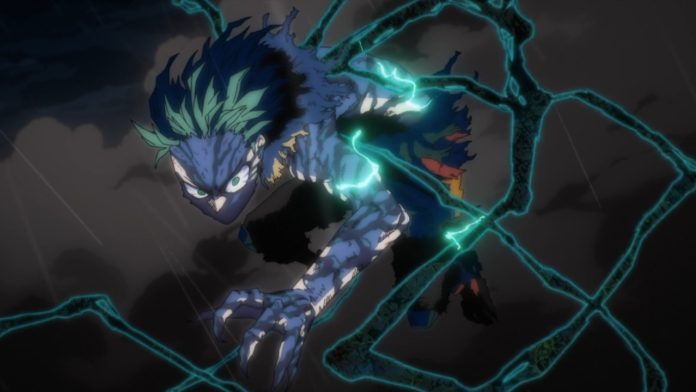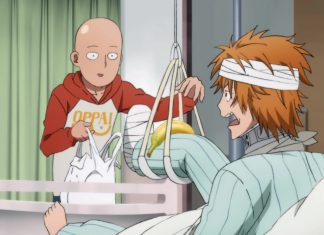In the heart-pounding penultimate stretch of My Hero Academia‘s final season, Episode 5—titled “History’s Worst Villain”—shifts the spotlight back to the raw, emotional core of the series: Izuku Midoriya’s unyielding quest to save even the most shattered souls. Airing amid the chaos of the ultimate hero-villain showdown, this installment trades explosive fisticuffs for piercing introspection, delving deep into Tomura Shigaraki’s fractured psyche while Deku grapples with the weight of his ideals. It’s a slower burn than the blistering action of prior episodes, but one that masterfully heightens the stakes, reminding us why this story has captivated fans for so long.
A Hero’s Resolve Amid the Ruins
The episode picks up right where the adrenaline-fueled clash between Katsuki Bakugo and All For One left off, thrusting us back into the brutal aerial duel between Deku and Shigaraki. High above the war-torn landscape, Deku—battered but unbreakable—pauses his assault, his eyes locking onto Shigaraki with a mix of sorrow and defiance. From the moment he first sensed the villain’s presence during his early days at U.A. High, Deku has seen beyond the monster: a terrified child, abandoned by a society that idolizes heroes but fails its most vulnerable. In a moment that encapsulates Deku’s growth, he vows not to end Shigaraki’s life, no matter the cost. Killing him would only perpetuate the endless cycle of hatred, Deku argues; instead, he clings to the dream of redemption, of pulling this lost boy back from the abyss.
This stance isn’t without pushback. A haunting vision, relayed through All Might’s lingering influence, brings words from the fallen American hero Star and Stripe into focus. She points out a faint crack in Shigaraki’s impenetrable core—a glimpse of the forlorn kid buried deep within, yearning for rescue. It’s a flicker of hope in an otherwise hopeless fray, but the vestiges of One For All aren’t so optimistic. Inside Deku’s mindscape, the spectral lineup of past users— from the stern Kudo to the more measured En—urges caution. They see Shigaraki as irredeemable, a force too warped by All For One’s manipulations to salvage. Yet Deku, ever the stubborn symbol of heroism, digs in his heels. His refusal to compromise, even as decay’s tendrils lash out, is both inspiring and agonizing, forcing viewers to confront the blurry line between mercy and self-destruction.
Shigaraki’s Shadow: Trauma Unveiled
On the flip side, Shigaraki—real name Tenko Shimura—rejects any notion of humanity with chilling finality. “I’m not human,” he snarls, his voice a guttural echo of years of suppressed agony, before extending a hand to rip away one of Deku’s hard-earned powers: the Float Quirk once held by the late Shinomori. This theft isn’t just a tactical blow; it’s a visceral reminder of Shigaraki’s arsenal, his Decay ability amplified to godlike levels, outstripping even All For One’s stolen might in sheer apocalyptic potential. He could end Deku in an instant during these lulls, but something holds him back—perhaps the vestiges of that inner child, clawing against the villain he’s become.
Interwoven throughout are gut-wrenching flashbacks that peel back Shigaraki’s origins like a festering wound. We see young Tenko, tears streaming down his dirt-streaked face, as his family’s tragic downfall unfolds. The crack motif—a literal and metaphorical fissure—pulses on screen, symbolizing the irreversible trauma inflicted by a “broken” Pro Hero system. When Tenko needed saving most, as his quirk spiraled out of control and claimed his loved ones, the world turned a blind eye. Not even All Might, the Symbol of Peace, swooped in to intervene. These sequences aren’t mere exposition; they’re a searing indictment of heroism’s flaws, showing how neglect birthed the very decay now threatening to consume everything. Shigaraki’s worldview, forged in isolation and rage, clashes violently with Deku’s optimistic “worldviews” lecture, where the young hero pleads for understanding over annihilation. It’s dialogue that cuts deeper than any punch, humanizing a villain we’ve rooted against for seasons.
Vestiges in the Void: Forging a Desperate Gambit
As the external battle simmers, the internal one boils over. The One For All remnants huddle in Deku’s subconscious, hashing out strategies with the urgency of cornered allies. En and Kudo’s heated exchange underscores the group’s fractures—practicality versus recklessness—but they coalesce around a high-risk ploy: exploit that crack in Shigaraki’s psyche. It’s Kudo’s wild idea at the forefront, a bid to weaponize empathy and potentially pry open a path to salvation. By episode’s close, the vestiges’ faith shifts from doubt to quiet resolve, rallying behind Deku as the embodiment of their legacy.
Sparks of Fury: Action in the Aftermath
True to the episode’s contemplative tone, the fisticuffs are sparse but impactful. Deku lands a devastating Delaware Smash, a air-pressure blast that sends shockwaves rippling through the sky and briefly staggers his foe. It’s a testament to his tactical mind, blending quirks like Blackwhip for reinforcement and Fa Jin for stored kinetic fury. But the real escalation comes in the final moments: Deku activates what looks like an Overlay or full Carnage mode, his form igniting in a blaze of multicolored energy. The screen fades on this powered-up silhouette, Shigaraki looming opposite, promising that the gloves are truly off next time.
Why This Episode Hits Different
For all its talky detours, “History’s Worst Villain” is a triumph of emotional architecture. The vibrant animation from Studio Bones shines in quieter beats—the swirling debris of a decaying world, the subtle tremors in Shigaraki’s expressions—proving that tension doesn’t always need nonstop spectacle. Deku’s arc feels profoundly earned here, a culmination of his “save everyone” mantra tested against the series’ darkest truths. If there’s a nitpick, it’s the pacing: Shigaraki’s hesitation feels narratively convenient, stretching the standoff when punches could have flown freer. Still, in a season racing toward apocalypse, this breather is a gift, forcing us to care about the “why” behind the war.
As the final battle hurtles forward, Episode 5 leaves us on a knife’s edge—will Deku’s light pierce Shigaraki’s shadows, or will decay claim the last hope? With the series bowing out soon, moments like these ensure My Hero Academia ends not with a whimper, but a defiant roar for a better tomorrow. If you’re not caught up, drop everything; this is peak shonen soul-searching.
BUMP OF CHICKEN performs the ending theme for the show’s eighth and concluding season. The ending theme is titled “I”.
Crunchyroll streams My Hero Academia season 8 anime worldwide excluding Asia.
The opening theme song “THE REVO” by Porno Graffitti.
RELEASE DATE FOR MY HERO ACADEMIA FINAL SEASON: October 4, 2025
My Hero Academia is a Japanese shonen manga crafted by Kōhei Horikoshi. Launched in Weekly Shōnen Jump on July 7, 2014, and concluding on August 5, 2024, it spans 430 chapters compiled into 42 tankōbon volumes. Set in a society where “Quirks” (superpowers) are widespread, the story centers on Izuku Midoriya, a Quirkless teen with ambitions of heroism. His life changes when All Might, the world’s top hero, recognizes his determination and passes on his Quirk, “One For All.” Midoriya joins U.A. High, an elite academy for aspiring heroes, navigating intense training, rivalries, and battles against villains. The manga blends dynamic action, emotional depth, and influences from Western superhero comics, earning over 100 million copies in circulation by April 2024, including spin-offs, cementing its status as a global phenomenon.
The anime adaptation, produced by Studio Bones, brings Horikoshi’s story to life with vivid animation and a compelling soundtrack. Premiering on April 3, 2016, it closely follows the manga, chronicling Midoriya’s growth at U.A. High and his clashes with villains like the League of Villains. The series spans seven seasons (with an eighth planned for October 2025), covering 158 episodes as of July 2025. Key seasons aired as follows: Season 1 (April–June 2016), Season 2 (April–September 2017), Season 3 (April–September 2018), Season 4 (October 2019–April 2020), Season 5 (March–September 2021), Season 6 (October 2022–March 2023), and Season 7 (May–October 2024). The anime also includes four films—Two Heroes, Heroes Rising, World Heroes’ Mission, and You’re Next—and ten OVAs. It’s lauded for its animation quality, voice acting (Japanese and English), and action, though some critique its pacing.
Kōhei Horikoshi is the manga’s writer and artist, inspired by his earlier works like Oumagadoki Zoo and a 2008 one-shot, My Hero. His love for Western superhero comics and shonen manga shaped the series’ unique style. The anime was helmed by Studio Bones, with Kenji Nagasaki directing, Yōsuke Kuroda scripting, Yoshihiko Umakoshi designing characters, and Yuki Hayashi composing music. Horikoshi contributed to the anime, notably on films and additional scenes.
The series has grown into a vast franchise, including spin-off manga (Smash!!, Vigilantes, Team-Up Missions), light novels, video games, stage plays, and merchandise. A live-action film by Legendary Entertainment is in development. The manga frequently topped The New York Times best-seller list, and the anime has garnered acclaim for its storytelling, art, and cultural nods to superhero comics, making it a cornerstone of modern anime and manga.
ALSO READ: Exploring Studio MAPPA’s Top 15 Anime Series: A Powerhouse of Modern Anime Innovation


